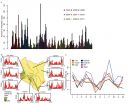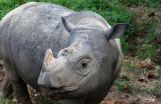(Press-News.org) CORVALLIS, Ore. - Myriad regulations and certification requirements around the world are making it virtually impossible to use genetically engineered trees to combat catastrophic forest threats, according to a new policy analysis published this week in the journal Science.
In the United States, the time is ripe to consider regulatory changes, the authors say, because the federal government recently initiated an update of the overarching Coordinated Framework for the Regulation of Biotechnology, which governs use of genetic engineering.
North American forests are suffering from an onslaught of threats including local and imported pests, as well as the impacts of a shifting climate. These threats pose "a real and present danger" to the future of many of our forest trees, notes Steven Strauss, a distinguished professor of forest biotechnology at Oregon State University and lead author on the analysis.
"The forest health crisis we're facing makes it clear that regulations must change to consider catastrophic losses that could be mitigated by using advanced forest biotechnologies, including genetic engineering," Strauss said. "With the precision enabled by new advances in genetic engineering - and their ability to make changes more rapidly and with less disruption to natural tree genetics than hybrid breeding methods - they can provide an important new tool."
In their analysis, Strauss and coauthors Adam Costanza, of the Institute of Forest Biosciences in Cary, North Carolina, and Armand Séguin of Natural Resources Canada in Quebec, argue that new regulatory approaches should be implemented in the United States and globally that focus on the product, not the process - and consider need, urgency and genetic similarity of modifications to those used in breeding.
The researchers note the striking discrepancy between the speed at which pests and changing climates are affecting trees and modifying both natural and planted forests, and the onerous and slow pace of regulatory review of genetically engineered trees that could be used to help fight these threats.
"If we have a technology that can help stop a forest health crisis, we should also have a regulatory system that can respond in a time frame that can make a difference," said Costanza, who is president of the Institute of Forest Biosciences.
The authors stress that they are not advocating for separate regulations for genetically engineered trees. Rather, they call for an approach that would give agencies the option to fast-track field research for products intended to address forest health problems or that use methods that modify natural genes and thus are comparable in scope to those of conventional breeding.
"Obviously, these changes will take time and require wide-ranging input," said Strauss, a professor in OSU's College of Forestry, "but we need to start now. We depend on forests for so many ecological, social and economic values - and all of these are being threatened.
"Why should we tie up a major tool like genetic engineering in excessive red tape?"
The authors point out that sustainable forest certification systems also are in need of a policy update. All major systems ban genetically engineered trees and will not certify any land as sustainable if genetically engineered trees are grown at all - even if the trees are being used solely for research or are designed to help stop a forest threat.
INFORMATION:
Are humans unsustainable 'super predators'?
Want to see what science now calls the world's "super predator"? Look in the mirror.
Research published today in the journal Science by a team led by Dr. Chris Darimont, the Hakai-Raincoast professor of geography at the University of Victoria, reveals new insight behind widespread wildlife extinctions, shrinking fish sizes and disruptions to global food chains.
"These are extreme outcomes that non-human predators seldom impose," Darimont's team writes in the article titled "The Unique Ecology of Human Predators."
"Our ...
Scientists have exposed a chink in the armour of disease-causing bugs, with a new discovery about a protein that controls bacterial defences.
Bacteria react to stressful situations - such as running out of nutrients, coming under attack from antibiotics or encountering a host body's immune system - with a range of defence mechanisms. These include constructing a resistant outer coat, growing defensive structures on their surface or producing enzymes that break down the DNA of an attacker.
The new research shows that a protein called sigma54 holds a bacterium's defences ...
WEST LAFAYETTE, Ind. -- Results of the XENON100 experiment are a bright spot in the search for dark matter.
The team of international scientists involved in the project demonstrated the sensitivity of their detector and recorded results that challenge several dark matter models and a longstanding claim of dark matter detection. Papers detailing the results will be published in upcoming issues of the journals Science and Physical Review Letters.
Dark matter is an abundant but unseen matter in the universe considered responsible for the gravitational force that keeps the ...
Scientists studying the 2009 A/H1N1 influenza pandemic have found that the inconsistent regional timing of pandemic waves in Mexico was the result of interactions between school breaks and regional variations in humidity.
The research published in PLOS Computational Biology, led by Dr. James Tamerius at the University of Iowa and Dr. Gerardo Chowell at Georgia State University, applied mathematical models to understand the social and environmental processes that generated two distinct pandemic outbreaks ("waves") in Mexico during the summer and fall of 2009.
The summer ...
Children who have been abused or exposed to other types of trauma typically experience more intense emotions than their peers, a byproduct of living in volatile, dangerous environments.
But what if those kids could regulate their emotions? Could that better help them cope with difficult situations? Would it impact how effective therapy might be for them?
A University of Washington-led team of researchers sought to address those questions by studying what happens in the brains of maltreated adolescents when they viewed emotional images, and then tried to control their ...
PRINCETON, N.J.--Tracking mobile phone data is often associated with privacy issues, but these vast datasets could be the key to understanding how infectious diseases are spread seasonally, according to a study published in the Proceedings of the National Academy of Sciences.
Princeton University and Harvard University researchers used anonymous mobile phone records for more than 15 million people to track the spread of rubella in Kenya and were able to quantitatively show for the first time that mobile phone data can predict seasonal disease patterns.
Harnessing ...
Glenview, Ill. (August 20, 2015)--The popularity of electronic cigarettes has steadily increased worldwide, but little is known about their effects on health. New research suggests that the single use of an electronic cigarette approximating the nicotine exposure of one tobacco cigarette reduces the sensitivity of the cough reflex.
The study tested 30 adult lifetime nonsmokers with no history of asthma or respiratory diseases and used cough tests to determine how e-cigarettes affect the cough reflex. Capsaicin, the pungent extract of red peppers, was used to induce a ...
Medicaid is expected to save billions of dollars a year as patents for several blockbuster antipsychotic medications expire and use of generic versions of these drugs increases, according to a new study by researchers at the University of Maryland School of Medicine. These savings may provide relief from the high costs of these medications and allow policymakers to lift restrictions on patients' access, the researchers argue.
The study forecast that annual Medicaid payments for antipsychotic medicines will decrease by nearly $1.8 billion (or nearly 50 percent) by 2016 ...
HOUSTON - (Aug. 20, 2015) - Rice University chemists who developed a unique form of graphene have found a way to embed metallic nanoparticles that turn the material into a useful catalyst for fuel cells and other applications.
Laser-induced graphene, created by the Rice lab of chemist James Tour last year, is a flexible film with a surface of porous graphene made by exposing a common plastic known as polyimide to a commercial laser-scribing beam. The researchers have now found a way to enhance the product with reactive metals.
The research appears this month in the ...
Leading scientists and experts in the field of rhino conservation state in a new paper that it is safe to consider the Sumatran rhinoceros extinct in the wild in Malaysia. The survival of the Sumatran rhino now depends on the 100 or fewer remaining individuals in the wild in Indonesia and the nine rhinos in captivity.
Despite intensive survey efforts, there have been no signs of the wild Sumatran rhinoceros (Dicerorhinus sumatrensis) in Malaysia since 2007, apart from two females that were captured for breeding purposes in 2011 and 2014. Scientists now consider the species ...



